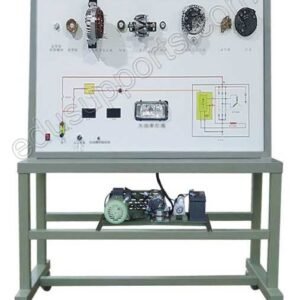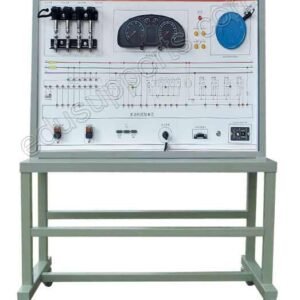En Entrenador hidráulico superior con sistema de doble bomba is the ultimate platform for mastering hydraulic circuit experiments, hydraulic applications, and comprehensive curriculum design. Tailored for colleges and vocational schools, this advanced trainer provides cutting-edge training and assessment in hydraulic drive systems and PLC control technology, featuring a variety of industrial-grade hydraulic components and a programmable controller module.
Key Training Capabilities of the Superior Hydraulic Trainer with Dual Pump System
- Comprehensive Hydraulic Transmission System Training
Experience the full spectrum of hydraulic systems with robust, real-world applications.
- Advanced Basic Hydraulic Circuit Experiments
Engage in dynamic hands-on learning with industrial-grade equipment.
- Performance Testing of Common Hydraulic Components (Optional)
Elevate understanding through detailed performance analysis.
- PLC Electrical Control Experiments: Machine-Electric-Hydraulic Integration
Integrate and master the synergy between machine control, electricity, and hydraulic power.
- Innovative T-Slot Training Panel Design
Quick and easy operation with rapid joint integration for all hydraulic components.
- Industrial-Grade Hydraulic Components and Valves
Withstand pressures up to 7MPa, featuring automatic pressure relief for ultimate safety.
- Modular Hydraulic System
Independent hydraulic modules with spring pin plates for effortless circuit assembly on the T-slot panel.
- Quick Coupling and Protected Electrical Connections
Students can confidently design and build up to 90 complex hydraulic circuits, with options to follow guided experiments or create custom configurations.
- Dual Control Modes: Relay Unit and PLC
Compare and contrast relay and PLC control for a deeper understanding of PLC advantages.
- Powerful Dual-Pump System
Combines a quantitative vane pump and a variable vane pump for versatile performance.
Hydraulic Circuit Training Modules
2.2 High-Speed Movement Circuits
- Differential fast-speed movement with one-way valve
- Fast-speed movement using two-position, three-way solenoid valve
2.3 Speed Shift Circuits
- Fast-slow speed transition circuits
- Bidirectional speed shift control
3.Circuitos de control direccional
3.1 Reversing Circuits
- Continuous reciprocating motion using two-position, four-way solenoid valve
- Reciprocating motion with three-position, four-way solenoid valve
3.2 Lock Circuits
- Locking via one-way valve
- Locking via pilot check valve
4.Circuitos de acción de control de varios cilindros
4.1 Sequential Action Circuits
- Sequence control with single and dual sequence valves
- Sequence control with travel switches, pressure relays
- Joint control with sequence valves and travel switches
4.2 Synchronization Action Control Circuits
- Oil-out throttle synchronization using speed regulating valves
- Bidirectional oil-inlet synchronization circuits
1.Circuitos de control de presión
1.1 Pressure Regulation Circuits
- Single-stage pressure regulation
- Two-stage pressure regulation
- Three-stage pressure regulation
- Remote port single-stage pressure regulation
- Remote port two-stage pressure regulation
- Dual-pressure control circuit
1.2 Pressure Reduction Circuits
- Reducción de presión de una etapa
- Two-stage pressure reduction
1.3 Pressure Holding Circuits
- Pressure holding via reversing valve
- Pressure holding via one-way valve
- Pressure holding via pilot check valve
1.4 Pressure Relief Circuits (Pressure-Venting)
- Two-position, two-way valve reversal circuit
- Three-position, four-way valve relief circuit (M-type and H-type mid-position functions)
- Solenoid valve-controlled double pump pressure relief
- Pressure-controlled double pump relief circuit
1.5 Balancing Circuits
- Balancing with sequence valve
- Balancing with pilot sequence valve
- Combined balancing and pressure holding circuit
- Balancing with pilot check and one-way throttle valve
1.6 Buffer Circuits
- Buffering via speed regulating valve
- Buffering via pressure relief valve
2.Circuitos de control de velocidad
2.1 Throttle Speed Regulation Circuits
- Oil-inlet throttle with speed regulation
- Oil-return throttle with speed regulation
- By-pass throttle speed regulation
- Bidirectional oil-inlet throttle speed regulation with one-way throttle valve
- Oil-return speed regulation with back pressure valve
PLC Electrical Control Experiments
- PLC programming and ladder logic instruction
- Software-based PLC programming and debugging
- PLC-to-computer communication
- PLC integration in hydraulic transmission systems
Hydraulic Component Performance Testing (Optional)
- Static performance of pressure relief/overflow valves
- Throttle valve characteristic testing
- Speed regulating valve performance evaluation
- Hydraulic pump performance testing
Throttle Speed Regulation Performance Testing (Optional)
- Speed-load characteristics of oil-inlet throttle circuits
- Speed-load analysis of by-pass throttle circuits
3D Dynamic Simulation and Control Experiments (Optional)
- Dynamic simulation and control software setup
- PLC programming and simulation debugging
- Real-time control and monitoring of basic hydraulic circuits
1.Motor A
- Potencia nominal:2 kW
- Fuente de alimentación:AC 380V
- Velocidad nominal:1440 rpm
2.Motor B
- Potencia nominal:5 kW
- Fuente de alimentación:AC 380V
- Velocidad nominal:1430 rpm
3.Bomba de paletas variables
- Desplazamiento:7 cc/rev
- Maximum Pressure:7 MPa
- Pressure Range:3-7 MPa
4.Quantitative Gear Pump
- Desplazamiento:8 cc/rev
- Presión nominal:7 MPa
Overall Dimensions
- Length × Width × Height:1570 × 660 × 1820 mm







